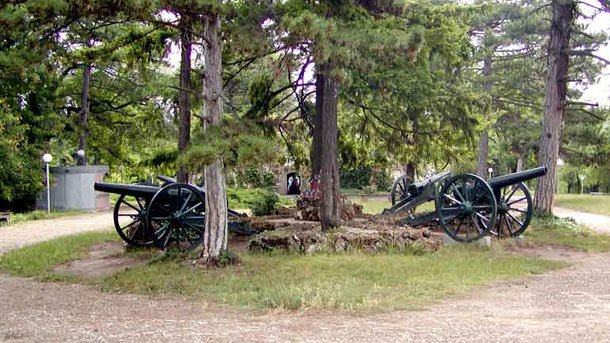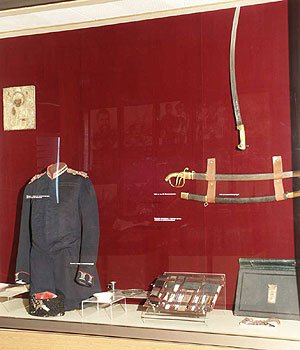There are many historical sites situated in the northern town of Pleven – the Mausoleum, the Skobelev Park, the 1877 Pleven Epopee Panorama, the Romanian Mausoleum etc. These are all related to the 1877 – 1878 Russo-Turkish War. The town is situated in the middle of the Danube Plain. Its military historical museums are among the oldest in this country, as they were opened soon after the 1878 Liberation from Ottoman rule. A bit over 300,000 people live nowadays on the municipality’s territory, 110,000 of those reside in Pleven.

© Photo: panorama-pleven.com
Most of the museums work 7 days per week, since there are many tourists, who want to visit them. Pleven has preserved unique weapons, military maps, uniforms and many other objects that witnessed the 5-month long siege back in 1877. Associate Prof. Milko Asparuhov, director of Pleven’s military history museums, writes in an article:

© Photo: panorama-pleven.com
“The town was of a major military, political and strategic importance during the war and the Pleven Epopee turned into one of the most significant moments in its history. The battles that were fought here appeared to be decisive for the entire war and the final victory and were also very intensive, large-scaled, long and bloody. The small town that nobody had heard of before focused then the attention, excitement, hopes and enthusiasm of the global community. After the victory Pleven’s citizens handed a thank you letter to the Russian Emperor Alexander I, reading that the Liberation of Bulgaria had begun here.”

© Photo: imagesfrombulgaria.com
The Russian army, supported by Romanian troops unsuccessfully attacked three times the Green Hills around Pleven. Numerous casualties were the result from the poor commandment of the Russians. Then they changed their tactics and the town had to spend three months under siege. On 10 November 1877 the Turkish garrison had to surrender after a break-through attempt. Its commanding officer Osman Pasha handed symbolically his sword, but it was returned to him as a sign of respect.

© Photo: panorama-pleven.com

© Photo: panorama-pleven.com
Nowadays tourists visiting Pleven can feel the war, if they want to, although in an illusionary manner. Back in 1907, the town’s citizens created the so-called Skobelev Park with the idea to express their gratitude to the famous Russian general. Seventy years later a strange building was constructed in the park – the 50 m long Pleven Epopee /or Panorama/. It is a huge truncated cone, symbolically raised by 4 big bayonets. The three horizontal rings that the corpus consists of symbolize the three unsuccessful attacks. The fourth reminds of the siege itself. The first hall represents historical events – the 1876 April Upraising, the fights at the Shipka Peak in the Balkan Range during the Russo-Turkish War etc. A huge, 100 m long and 15 m tall canvas is displayed in the big, panoramic hall. It is covered with realistic pictures, re-creating the September 1877 battle. The 3D effect is incredible, since the drawings depict in depth the main events and those are inwrought by different real objects – guns, barrels, wagons, Turkish and Russian military uniforms full with straw, even trenches have been dug in the hall… The illusion is for a perspective of some 10 km. One has the feeling that he or she is just one step away from the cannons and the whistling bullets.

© Photo: panorama-pleven.com
Russian artist and head of the mixed team of 13 Nikolay Ovechkin has demonstrated mastery all over the Panorama. Visitors can use the elevators and go up to the two landings from where all the battles can be seen. A remarkable fact – the whole facility was built up and drawn in the course of only 8 months, as many volunteers took part in the work. The Panorama was unveiled on 10 November 1977, honoring the 100th anniversary since the liberation of Pleven. One can see in one of the halls a plaque with an inscription A Testament to the Next Generations. A metal capsule was walled behind it that has to be opened at the same date in 2077. The citizens of Pleven placed there some advice for the forthcoming generations.
English version: Zhivko Stanchev
In its centuries-old history, the Etropole Monastery "Holy Trinity", also called "Varovitets", has been preserving valuable pages decorated by skilled artists. Here hundreds of years ago, one of the most productive literary schools in Bulgarian..
Cape Kaliakra is one of the most picturesque places along Bulgaria’s Black Sea coast. The narrow rocky peninsula cuts 2 kilometers through the sea. Its steep slopes are 60-70 meters high. The waves have cut deep niches and caves..
As a result of glacial erosion during the Quaternary era, clusters of lakes were formed in the higher reaches of Rila Mountain, an essential element of the landscape. The string of the seven lakes of Rila is the longest, most scenic and most..

+359 2 9336 661
